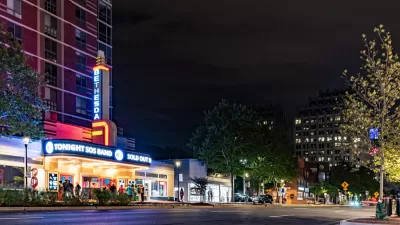Urban planners like the nightlife. They like to boogie. But one researcher argues that planners should better understand how to balance the positive and negative effects of a bustling nightlife.

Deutsche Welle runs an interview with urban scientist Jakob F. Schmid, of HafenCity University in Hamburg, who explains why planners develop a more thorough understanding of how bars and clubs operate in the wee hours of the night.
According to Schmid, his native country of Germany has done very little on the planning implications of nightlife, so "the discourse about it tends to be problem-focused and very restrictive."
"Unlike areas such as retail, local authorities and urban planners know very little about the patterns of the night economy. With our research project 'City After Eight' we want to make an impact and offer formula-based recommendations for urban planning and city marketing," says Schmid.
The article features insight into the graphic representation of the nightlife in 12 cities, as created by Schmid's research team. Schmid also notes the stronger tradition for researching the planning implications of nightlife in the United Kingdom.
FULL STORY: Why urban planners should pay attention to nightlife

Alabama: Trump Terminates Settlements for Black Communities Harmed By Raw Sewage
Trump deemed the landmark civil rights agreement “illegal DEI and environmental justice policy.”

Study: Maui’s Plan to Convert Vacation Rentals to Long-Term Housing Could Cause Nearly $1 Billion Economic Loss
The plan would reduce visitor accommodation by 25% resulting in 1,900 jobs lost.

Why Should We Subsidize Public Transportation?
Many public transit agencies face financial stress due to rising costs, declining fare revenue, and declining subsidies. Transit advocates must provide a strong business case for increasing public transit funding.

Paris Bike Boom Leads to Steep Drop in Air Pollution
The French city’s air quality has improved dramatically in the past 20 years, coinciding with a growth in cycling.

Why Housing Costs More to Build in California Than in Texas
Hard costs like labor and materials combined with ‘soft’ costs such as permitting make building in the San Francisco Bay Area almost three times as costly as in Texas cities.

San Diego County Sees a Rise in Urban Coyotes
San Diego County experiences a rise in urban coyotes, as sightings become prevalent throughout its urban neighbourhoods and surrounding areas.
Urban Design for Planners 1: Software Tools
This six-course series explores essential urban design concepts using open source software and equips planners with the tools they need to participate fully in the urban design process.
Planning for Universal Design
Learn the tools for implementing Universal Design in planning regulations.
Smith Gee Studio
Alamo Area Metropolitan Planning Organization
City of Santa Clarita
Institute for Housing and Urban Development Studies (IHS)
City of Grandview
Harvard GSD Executive Education
Toledo-Lucas County Plan Commissions
Salt Lake City
NYU Wagner Graduate School of Public Service




























